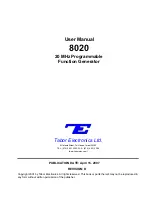
10
REV B
OPM-111
Wire Temperature Rating
Cu Conductor
Al Conductor
kW
Volts
PH Amp
75°C
90°C
75°C
90°C
21
120/240
1
90
#2 AWG #3 AWG 1/0 AWG #2 AWG
21
120/208
3
80
#3 AWG #4 AWG #2 AWG #3 AWG
21
120/240
3
80
#3 AWG #4 AWG #2 AWG #3 AWG
22
277/480
3
35
#8 AWG #8 AWG #4 AWG #6 AWG
30/27 120/240
1
125 1/0 AWG #1 AWG 3/0 AWG 2/0 AWG
30/28 120/208
3
100 #2 AWG #3 AWG 1/0 AWG #1 AWG
30/28 120/240
3
100 #2 AWG #3 AWG 1/0 AWG #2 AWG
30/28 277/480
3
45
#6 AWG #8 AWG #4 AWG #6 AWG
For additional information on wire sizing refer to table 310-16 of the
National Electrical Code ANSI/NFPA 70.
C - Ground Lug, These ground lugs are bonded to ground and are
provided for you to connect your ground wire from the transfer switch
to. The lugs on the 21/30 kW will accommodate #6 AWG to 250 MCM
and should be torqued to 50 in. lbs.
D. 120 Volt Terminal Block. These terminals are for shore power. For a
power line with one lead, plug into either terminals, ensuring the jumper
is still connected. To isolate two leads for use of two separate circuit
breakers, the jumper must be removed.
WARNING: EQUIPMENT DAMAGE:
When installing a three-phase 240 Volt system, be sure you know
which lead is the high voltage “wild” leg (208 Volt to neutral). The
generator normally carriers the high voltage on the G2 lead.
The load current carrying wires (L) and (T) must be sized to handle
the maximum load current without excessive voltage drop. By code,
the wire must be heavy enough to handle the full current rating of
the mainline circuit breaker (or fuse) in the entrance (or sub-panel)
protecting the contactor switch.
All wires should be installed in rigid or flexible conduit. (knockouts are
provided in the control box).
GROUNDING
A grounding lug has been provided on the engine generator set. Check
your local codes for proper grounding requirements.
AC ELECTRICAL CONNECTIONS
NOTICE:
CLASS 1 WIRING METHODS ARE TO BE USED FOR ALL FIELD
WIRING CONNECTIONS TO TERMINAL OF A CLASS 2 CIRCUIT.
WARNING:
A mainline circuit breaker has been provided inside the generator
housing. During all wiring installation, make sure the breaker is in the
off position and the generator operators switch is in the off position.
A - Neutral Lugs, These neutral lugs are isolated from ground and
provided for you to connect your neutral wire from the transfer
switch. The lugs on the 21 kW will handle wire sizes #12 AWG to 2/0
AWG and should be torqued to 50 in lbs. The lugs on the 30 kW will
accommodate #12 AWG to 2/0 AWG and should be torqued to 50 in
lbs.
B - Generator Circuit Breaker, This circuit breaker provides overload
protection for the generator. Your power feeds from the transfer switch
will connect to the bottom lugs on the circuit breaker. The generator
power feeds have already been wired into the upper lugs.
The table below gives you the circuit breaker size, lug wire sizes and
torque specification. (see the actual breaker for additional information
and restrictions)
kW
Volts
PH
Amp
Wire Capability
Lug Torque
21
120/240 1
90
#12 AWG-2/0 AWG
50 in lbs
21
120/208 3
80
#12 AWG-2/0 AWG
50 in lbs
21
120/240 3
80
#12 AWG-2/0 AWG
50 in lbs
22
277/480 3
35
#14-#10 AWG
80 in lbs
30/27 120/240 1
125
#12 AWG-2/0 AWG
50 in lbs
30/28 120/208 3
100
#12 AWG-2/0 AWG
50 in lbs
30/28 120/240 3
100
#12 AWG-2/0 AWG
50 in lbs
30/28 277/480 3
45
#14-#10AWG
80 in lbs
The previous table shows the minimum conductor sizes between the
generator and the ATS, based on wire type and temperature rating.
Wire has been derated 40° C ambient temperatures.
A
C
B
D






































